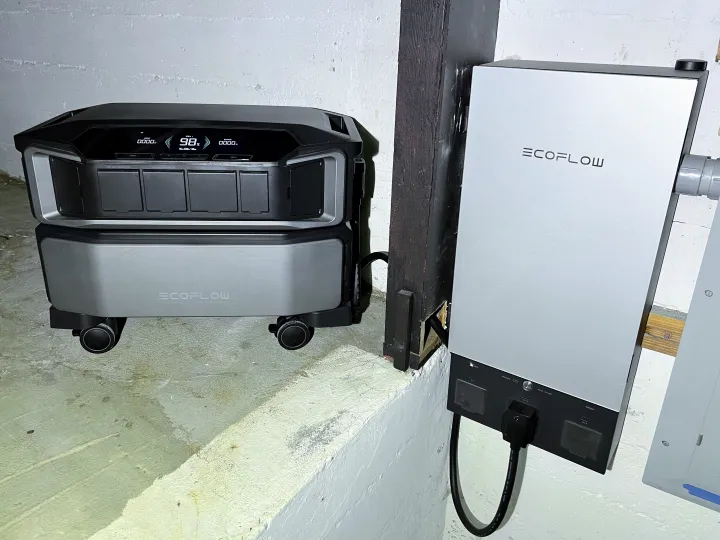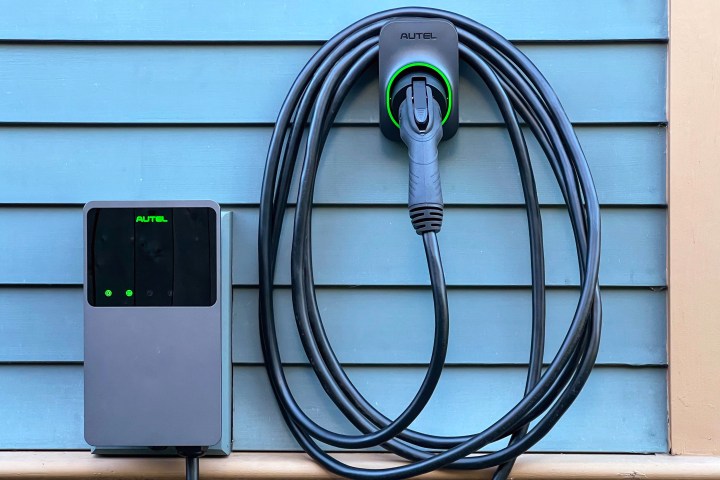
On long stretches of highway, when the landscape turns to stubbly farmland and episodes of Search Engine get stale, I have a secret Rubik’s cube for my idle mind: planning gas stops. Say what you will about the futility of saving pennies, I still do a mental fist pump from cruising past a $4.89 gas station with a tank I just topped off at $3.51.
It’s dumb. And fun. And if you thought that couldn’t get much more pitiful, now I’m doing it with electricity.

For the past few weeks, I’ve been living with the EcoFlow Delta Pro Ultra and Smart Home Panel 2, two new devices the company announced at CES 2024. This goliath battery power station and its accompanying electrical panel allow me to click my home’s wiring on and off the grid with a button press. Every day, I can game my utility bill by hoarding cheap wattage at night and releasing it at peak rate times. And when the grid goes down, my house hums on without missing a beat.
Here’s what it’s like to live with a home with secret superpowers, why EcoFlow’s new hardware differs from some of the other options, and what you might want to consider before making the leap yourself.
Home, home on the grid
Home energy storage systems are not new, although you could be forgiven for thinking that after seeing how many are hitting the market right now. Anker just launched the competing Solix F3800, and Bluetti began selling the EP900 earlier this in 2023. But Tesla introduced its Powerwall – perhaps the most recognizable product in the space – in 2015. And for more intrepid homeowners, a host of companies with less recognizable names, like Sol-Ark and EG4, sell part-by-part alternatives. But EcoFlow is offering a setup that’s simpler, more versatile, and, in some ways, better.
Crucially, the Delta Pro Ultra is still a mobile power station. Unlike the Tesla Powerwall and a myriad of other systems that mount to your wall forever, it rolls. Not easily, mind you – the 116-pound battery portion is hernia bait for overly confident middle-aged dads everywhere. But it comes with casters, a dolly, and a panoply of outlets to plug into without hardwiring into a home, including heavy-duty 30A outlets.

Imagine loading it in your RV for a week away from home. Or bringing it up to your off-grid cabin. Or being the hero who drops this sucker off with a friend when their power goes out. You can’t do that with a Powerwall.
EcoFlow is also using a different class of batteries. While the Tesla Powerwall uses the same nickel-manganese-cobalt (NCM) batteries found in Tesla cars, EcoFlow uses lithium-iron-phosphate (abbreviated LiFePO4 or LFP) cells. They’re cheaper, use fewer rare earth minerals, and, importantly, they don’t carry the same risk of unstoppable 3,600-degree fires, which is a nice perk for a cooler-sized battery you intend to cohabitate beside.
Many specialized vendors also use LFP cells but sell something closer to a kit than a product. You’ll need to select inverters, batteries, cables, and terminals and turn your garage or basement wall into a maze of switches, wires, and LEDs. The EcoFlow is pretty much a one-stop shop.

Well, three stops if we’re being literal: The Delta Pro Ultra battery plugs into the Delta Pro Ultra inverter, which plugs into the Smart Home Panel 2, which is hardwired into your home. Once it’s all wired up, you control it all with one app – and that’s where the real magic happens.
The brains of the operation
My electricians set up the Smart Home Panel 2 as a subpanel, meaning it feeds off my main circuit breaker. I got to choose up to 10 circuits to move from my main breaker into the Smart Home Panel 2 – these are the only circuits I can power in an emergency, so I had to choose wisely. My refrigerator, heat pump, and Wi-Fi router made the cut – hot tub, not so lucky. Is it asking so much to luxuriate in bubbling 104-degree water while the world around you blinks into darkness? Yes.

While we’re talking about installation, it’s worth mentioning that since it took a team of three electricians a solid workday to wire this panel into my home, the review system that EcoFlow supplied at no cost will not be going anywhere. I’ll judge it as candidly as anything I’ve written about for this site, but given the value of the hardware and labor involved, you should know the circumstances.
In the Smart Home Panel 2’s most basic setup, it will simply switch every circuit inside to battery power during a power outage. The grid goes down; the fridge stays running. But it can get much more sophisticated than that.
Using the EcoFlow app, you can monitor each circuit and see precisely how much juice it’s using, either in real time, or over days, weeks, and months. This level of visibility lets you make smart decisions about where you “spend” your power in an outage.

For instance, I discovered that my kitchen appliances run on the same circuit as my basement radon fan, which draws about 120 watts day and night. So in a power outage, I’d turn the whole circuit off unless I need to, you know, make toast. Let the radon hang out for a few days.
You can do this manually or set up an “outage strategy” to automatically shut down some circuits when grid power blinks out. I can set it up to automatically cut off my kitchen circuits or feed them until the battery reaches a specified level, like 50%. As you remove or restrict more circuits, you can watch your estimated battery runtime increase proportionally based on historical data the panel has collected from tracking them. It’s very, very slick.
Runtime and capacity
So, how long can you expect to get by with your EcoFlow Delta Pro Ultra until the watts peter out? The Delta Pro Ultra offers 6.14kWH of capacity, a number that I know won’t mean much to most people. For context, that’s massive on the scale of portable battery packs (the beefy Geneverse HomePower Two Pro offers just 2.4kWh in comparison) but not much on the scale of electric cars (the most basic Tesla Model 3 you can buy packs 50kWh). The Tesla Powerwall 2 offers more than double at 14kWh, while the more modest Anker Solix F3800 offers 3.8kWh.

Meanwhile, the average American household uses 28kWh a day. You probably don’t need a calculator to realize that 6kWh won’t take you far unless you modify your usage. That’s why the Smart Home Panel 2 is a necessary scalpel to pare down to just the essentials – and even they can be thirsty. My refrigerator alone uses 2.28kWh per day. Two days of emergency power, used judiciously, is probably realistic for many homes.
If that sounds insufficient for The Big One you’re expecting to rattle your city to shambles, you can also tack on extra batteries up to a total of 90kWh, which stack on the existing system like Lego bricks. Or you can augment this setup with two off-the-grid options: a generator or a solar array. My home doesn’t have either, but here’s how they work in principle.
Rip the cord on a generator, flip a switch in the Smart Home Panel 2, and you’ve essentially replaced the grid with gas, but as you’ll notice, it’s not fully automatic. Since a generator can top up the battery (in addition to powering your stuff) while it’s running, you can minimize the drone of an engine outside your house by running it for a couple hours a day, then coasting on battery.
Solar is much more convenient. You connect it directly to the Delta Pro Ultra inverter through one of two ports: One for the sort of small portable panels that EcoFlow sells and another for the type of permanently installed system that might be on your roof. The latter will accommodate up to 4kW for each inverter in your stack, up to a maximum of 12kW. Tesla’s unreleased Powerwall 3, in comparison, handles up to 11.5kW but does it with one box. Because you’re feeding DC solar power directly to DC batteries, it’s also more efficient than a setup like the Powerwall 2, which requires your solar power to be converted from DC to AC and back to DC for storage.
Cheap watts all day long
Preparing for an electrical apocalypse will please preppers, but as I alluded, there’s something in it for cheapskates, too. When I installed my EV charger, my utility automatically switched my electricity billing from flat-rate to time-of-use (TOU) billing. That means I pay a discounted 8-cent-per-kWh rate almost all day long, but for four hours every evening, my rates skyrocket to 25 cents per kilowatt hour.

Most utilities offer a similar arrangement to help take the load off their grid during peak hours. If you adjust your habits a bit, you can save money and ease the strain on your community’s infrastructure. I’ve already set my car to charge during off-peak hours, but as you can imagine, not all electricity use can wait. I’m not waiting until 9 p.m. to make dinner.
Enter the battery in my basement. A dedicated time-of-use mode in the EcoFlow app lets you enter the timing of your peak hours, and the panel will charge the battery when watts are cheap and then draw from it when they’re expensive. Voila. There are, of course, all sorts of options, but in principle, you can set this up once and never worry about it again. Your home will connect to and from the grid without missing a beat.

Mostly. There is one other tell-tale sign I’m on battery power: Some of my LED lights blink. A few of the LED bulbs in my standard fixtures and my recessed LED ceiling lights exhibit a barely perceptible winking while I’m on battery power. It wasn’t even enough for my wife to notice, but depending on your sensitivity, you may question whether the savings are worth it.
Speaking of which, what are the savings?
Counting pennies
We’ve established that this system can handle taking your home off the grid during peak hours, but does that make any financial sense? Stay with me here; we need to talk numbers.
EcoFlow hasn’t provided me with final pricing yet but suggested that the EcoFlow Delta Pro Ultra inverter bundled with one battery will cost around $6,000. The Smart Home Panel 2 hasn’t been priced yet, but let’s assume it sells for the same $1,600 as its predecessor. With the 30% discount available through the Inflation Reduction Act, you’re looking at $5,320 on hardware and then about $3,000 on installation. It’s realistic to say you could own this setup for $8,320, all in.
I can save a maximum of 94 cents per day, or $343 per year.
Every kilowatt hour I can pull from a battery during peak rates saves me 17 cents since I bought it for 8 cents when it would cost me 25 cents from the grid. That means if I use the Delta Pro Ultra’s full capacity (90% of 6.14kWh because it won’t let you use 100%) in a single day, I can save a maximum of 94 cents per day, or $343 per year.
If you’re unimpressed, perhaps that’s because you’ve calculated that even over the battery’s estimated 10-year lifetime, it could save me a maximum of $3,430. I’d be nowhere near breaking even, much less realizing a net benefit. In Hawaii, where rates may jump 40 cents at peak usage, you’d almost recoup your cost with $8,068 saved over 10 years. But most of us should probably view the time-of-use features as the icing, not the cake.
That’s a lot of watts
For most homeowners, the cake is the peace of mind of knowing that their homes can keep humming even when the grid goes down. It’s a little astonishing to look at a box the size of the Delta Pro Ultra and realize it can do that, but with a healthy 7,200 watts of output, it was up to the task for my home. It puts even the 5,000-watt Bluetti AC500 I dragged into the woods to shame. And my home was up to the task of flogging it.
I just swapped my aging gas furnace for a 3-ton heat pump this summer, which means all of my home’s heating and cooling relies on electricity – and a lot of it. When running, the heat pump uses 3,100 watts of electricity, and like all compressors, it likely glugs much more on startup. The Delta Pro Ultra doesn’t seem to notice. In 30-degree weather, I can comfortably keep my home at a toasty 71 degrees on battery power.
Of course, that’s just a baseline. I still need to run computers, Wi-Fi routers, and light bulbs! None of that really gave the Delta Pro Ultra a challenge, so I set about upping the ante. I turned on every light in the house. I turned on my toaster oven. Started boiling water in my electric kettle. Plugged in my 120V hot tub with an extension cable. Please don’t tell the fire marshall. As my pièce de résistance, I fired up a table saw, which only managed to pop the 15-amp circuit breaker it was plugged into. The Delta Pro Ultra chugged on.
Bottom line: 7,200 watts is more than enough for critical loads. Consuming much more than that won’t take you very far with a battery this size, anyway.
The right system for the right person
If you live near cheap, reliable power, it’s probably easy to see home backup systems as toys for rich nerds. But there are all sorts of people in other situations who will see much more.
First off, solar owners. Many people don’t realize that solar panels on your roof are useless when the grid is down unless they’re connected to a battery. This setup is probably one of the easiest ways to get that autonomy. And the relatively limited storage of the base configuration is less of an issue when you’re constantly pouring in a fresh supply of sweet, clean solar power.
If you live in an area with frequent, brief power disruptions, this setup could make much more sense than a dedicated generator. It’s cleaner, quieter, you’ll never have to wrench on it, and your friends will be pretty damn impressed when you bring it to the next tailgate.
If you’re prepping for disaster, the type that might last more than 24 hours, the limited storage on the Delta Pro Ultra will probably give you pause. But paired with even a $500 generator, you have an unbeatable belt and suspenders that will have you praying for an ice storm.



